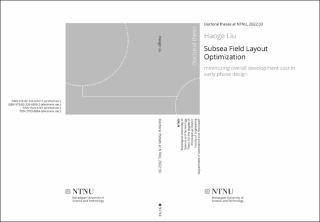| dc.description.abstract | This study focuses on building a systematic method for the subsea field layout optimization with the aim of minimizing the overall field development cost. The subsea field layout optimization is a very complex problem which mainly includes well trajectories, location-allocation of subsea facilities (mainly the manifolds), flowline and umbilical routing, and location-allocation of drilling sites. Because the function of flowline and umbilical is to connect the well heads and subsea facilities, we simplify the flowline and umbilical routing as a cost function into the location-allocation of subsea facilities. Hence the complex problem is divided into 3 sub-problems: the “1-site-n-wells” problem, the “location-allocation of manifolds” problem and the “k-sites-n-wells” problem.
We extend the original 2D Dubins Curve to the 3D drilling scenario to solve the “1- site-n-wells” problem where we can find the best drilling site location and the wellbore trajectories for multiple wells to be drilled from the same drilling site. A binary linear programming (BLP) method which guarantees the global optimum with extreme high efficiency is created to solve “location-allocation of manifolds” problem. The 3D Dubins
Curve method and the BLP method are then systematically combined to solve the “ksites-n-wells” problem. Thus, the systematic method for the subsea field layout optimization is built, and the method has the flexibility to handle various user-defined cost and constraints.
Abundant case studies and a real field data test provided by a SUBPRO industrial partner validate the correctness and the advantage of our method both in accuracy and efficiency.
We are confident that our method will benefit the petroleum industry in the future and the BLP method will have a wider application in various areas where the problems can be deduced as a size-constrained clustering problem. | en_US |
